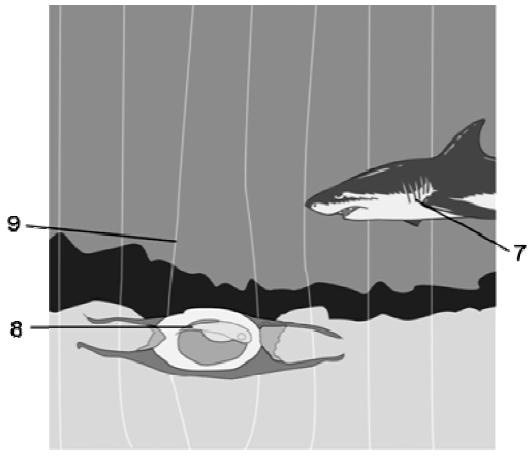Electroreception - IELTS Reading Answers
13 min read
Updated On
-
Copy link
Electroreception IELTS Reading Answers comes with 13 questions covering three types of IELTS Reading questions. Take this reading test and be prepared to handle these question types for a band 9 in IELTS Reading.
Table of Contents

Limited-Time Offer : Access a FREE 10-Day IELTS Study Plan!
Electroreception IELTS Reading Answers is an IELTS Academic Reading passage that discusses electro reception, a sensory ability found in aquatic and amphibian species. While understanding unfamiliar words like electro reception is important, IELTS Reading is more about assessing multiple reading skills, like skimming, scanning, and detailed reading.
The reading passage, Electroreception Reading Answers, will help you develop these skills to achieve a high IELTS band score. Therefore, in this article, we will delve into the practice of the three different types of IELTS Reading questions, review answers for identifying areas of improvement and share some essential reading tips needed to excel in the exam.
Reading Passage for Electroreception Reading Answers
Go through the Electroreception IELTS Reading Answers passage given below and prepare yourself for the reading section with this IELTS Reading practice test.
Electroreception
A Open your eyes in sea water and it is difficult to see much more than a murky, bleary green colour. Sounds, too, are garbled and difficult to comprehend. Without specialised equipment humans would be lost in these deep sea habitats, so how do fish make it seem so easy? Much of this is due to a biological phenomenon known as electroreception – the ability to perceive and act upon electrical stimuli as part of the overall senses. This ability is only found in aquatic or amphibian species because water is an efficient conductor of electricity.
B Electroreception comes in two variants. While all animals (including humans) generate electric signals, because they are emitted by the nervous system, some animals have the ability – known as passive electroreception – to receive and decode electric signals generated by other animals in order to sense their location.
C Other creatures can go further still. However, animals with active electroreception possess bodily organs that generate special electric signals on cue. These can be used for mating signals and territorial displays as well as locating objects in the water. Active electroreceptors can differentiate between the various resistances that their electrical currents encounter. This can help them identify whether another creature is prey, predator or something that is best left alone. Active electroreception has a range of about one body length – usually just enough to give its host time to get out of the way or go in for the kill.
D One fascinating use of active electroreception – known as the Jamming Avoidance Response mechanism – has been observed between members of some species known as the weakly electric fish. When two such electric fish meet in the ocean using the same frequency, each fish will then shift the frequency of its discharge so that they are transmitting on different frequencies. Doing so prevents their electroreception faculties from becoming jammed. Long before citizens’ band radio users first had to yell “Get off my frequency!” At hapless novices cluttering the air waves, at least one species had found a way to peacefully and quickly resolve this type of dispute.
E Electroreception can also play an important role in animal defences. Rays are one such example. Young ray embryos develop inside egg cases that are attached to the sea bed. The embryos keep their tails in constant motion so as to pump water and allow them to breathe through the egg’s casing. If the embryo’s electroreceptors detect the presence of a predatory fish in the vicinity, however, the embryo stops moving (and in so doing ceases transmitting electric currents) until the fish has moved on. Because marine life of various types is often travelling past, the embryo has evolved only to react to signals that are characteristic of the respiratory movements of potential predators such as sharks.
F Many people fear swimming in the ocean because of sharks. In some respects, this concern is well grounded – humans are poorly equipped when it comes to electroreceptive defence mechanisms. Sharks, meanwhile, hunt with extraordinary precision. They initially lock onto their prey through a keen sense of smell (two thirds of a shark’s brain is devoted entirely to its olfactory organs). As the shark reaches proximity to its prey, it tunes into electric signals that ensure a precise strike on its target; this sense is so strong that the shark even attacks blind by letting its eyes recede for protection.
G Normally, when humans are attacked it is purely by accident. Since sharks cannot detect from electroreception whether or not something will satisfy their tastes, they tend to “try before they buy”, taking one or two bites and then assessing the results (our sinewy muscle does not compare well with plumper, softer prey such as seals). Repeat attacks are highly likely once a human is bleeding, however; the force of the electric field is heightened by salt in the blood which creates the perfect setting for a feeding frenzy. In areas where shark attacks on humans are likely to occur, scientists are exploring ways to create artificial electroreceptors that would disorient the sharks and repel them from swimming beaches.
H There is much that we do not yet know concerning how electroreception functions. Although researchers have documented how electroreception alters hunting, defence and communication systems through observation, the exact neurological processes that encode and decode this information are unclear. Scientists are also exploring the role electroreception plays in navigation. Some have proposed that salt water and magnetic fields from the Earth’s core may interact to form electrical currents that sharks use for migratory purposes.
Electroreception Reading Answers Questions
There are 13 questions in Electroreception IELTS Reading Answers, which showcase three different IELTS Reading question types. They are:
- IELTS Reading Matching Information (Q. 1-6)
- IELTS Reading Diagram Completion (Q. 7-9)
- IELTS Reading Summary Completion (Q. 10-13)
Set a timer and complete these questions within the allotted time!
Questions 1-6
The Reading Passage has eight paragraphs, A–H.
Which paragraph contains the following information?
Write the correct letter, A–H, in boxes 1–6 on your answer sheet.
1 How electroreception can be used to help fish reproduce
2 A possible use for electroreception that will benefit humans
3 The term for the capacity which enables an animal to pick up but not send out electrical signals
4 Why only creatures that live in or near water have electroreceptive abilities
5 How electroreception might help creatures find their way over long distances
6 A description of how some fish can avoid disrupting each other’s electric signals
Questions 7-9
Label the diagram.
Choose NO MORE THAN TWO WORDS from the passage for each answer.
Write your answers in boxes 7–9 on your answer sheet.

Shark’s 7 ………………… alert the young ray to its presence
Embryo moves its 8………………… in order to breathe
Embryo stops sending 9 ………………… when predator close by
Questions 10-13
Complete the summary below.
Choose NO MORE THAN THREE words from the passage for each answer.
Write your answers in boxes 10–13 on your answer sheet.
Shark Attack
A shark is a very effective hunter. Firstly, it uses its 10 ……………….. to smell its target. When the shark gets close, it uses 11 ……………….. to guide it toward an accurate attack. Within the final few feet the shark rolls its eyes back into its head. Humans are not popular food sources for most sharks due to their 12………………… Nevertheless, once a shark has bitten a human, a repeat attack is highly possible as salt from the blood increases the intensity of the 13…………………
Do you have a book with everything from tips, strategies to Practice Tests
for IELTS Academic Reading?
If not, check out the IELTS Reading Academic Test Guide!
Electroreception IELTS Reading Answers with Location and Explanation
Compare your answers for Electroreception IELTS Reading Answers, with the answer key below. Make sure to create customized strategies from the feedback from the practice of this IELTS Reading recent actual test.
1 Answer: C
Question type: Matching Information
Answer location: Paragraph C, line 2 – line 3
Answer explanation: In the third paragraph, it is stated that “However, animals with active electroreception possess bodily organs that generate special electric signals on cue. These can be used for mating signals…”. It can be concluded that the information regarding how electroreception can be used to help fish reproduce, i.e., animals with electroreception have organs that generate electric signals that help them in mating (reproduction), is given in the third paragraph of the passage. Hence, the answer is C.
2 Answer: G
Question type: Matching Information
Answer location: Paragraph G, line 4
Answer explanation: In the mentioned paragraph, it is given “In areas where shark attacks on humans are likely to occur, scientists are exploring ways to create artificial electroreceptors that would disorient the sharks and repel them from swimming beaches.”. The above-mentioned sentence from Paragraph G lists that scientists can use electroreception to disorient sharks and repel them from swimming beaches, thereby benefiting humans. Hence, the answer is G.
3 Answer: B
Question type: Matching Information
Answer location: Paragraph B, line 2
Answer explanation: In the specified paragraph, it is given “…some animals have the ability – known as passive electroreception – to receive and decode electric signals generated by other animals in order to sense their location.”. In other words, the second paragraph of this passage informs about the capacity which enables an animal to pick up but not send out electrical signals, which is termed as passive electroreception. Hence, the answer is B.
4 Answer: A
Question type: Matching Information
Answer location: Paragraph A, line 5
Answer explanation: The first paragraph ends with the statement “This ability is only found in aquatic or amphibian species because water is an efficient conductor of electricity.”. It points out that the first paragraph tells us the reason why only creatures that live in or near water have electroreceptive abilities (water is an efficient conductor of electricity). Hence, the answer is A.
5 Answer: H
Question type: Matching Information
Answer location: Paragraph H, line 3 – line 4
Answer explanation: Through the last two sentences of the concluding paragraph, “Scientists are also exploring the role electroreception plays in navigation. Some have proposed that salt water and magnetic fields from the Earth’s core may interact to form electrical currents that sharks use for migratory purposes.”, it can be concluded that this paragraph refers to the ways how electroreception might help creatures find their way over long distances. Hence, the answer is H.
6 Answer: D
Question type: Matching Information
Answer location: Paragraph D, line 2 – line 3
Answer explanation: In the fourth paragraph, it is written “When two such electric fish meet in the ocean using the same frequency, each fish will then shift the frequency of its discharge so that they are transmitting on different frequencies. Doing so prevents their electroreception faculties from becoming jammed.”. It points out the fact that the fourth paragraph explains how some fish can avoid disrupting each other’s electric signals. Hence, the answer is D.
7 Answer: respiratory movements
Question type: Diagram Completion
Answer location: Paragraph E, line 6
Answer explanation: In Paragraph E, it is said that “Because marine life of various types is often travelling past, the embryo has evolved only to react to signals that are characteristic of the respiratory movements of potential predators such as sharks.”. This indicates that the shark’s respiratory movements alert the embryo of the young ray to its presence. Hence, the answer is ‘respiratory movements’.
8 Answer: tail
Question type: Diagram Completion
Answer location: Paragraph E, line 4
Answer explanation: The following line –The embryos keep their tails in constant motion so as to pump water and allow them to breathe through the egg’s casing.– establishes the fact that the ray embryo moves its tail in constant motion in order to breathe. Hence, the answer is ‘tail’.
Unlock Explanations
9 Answer: electric current
Question type: Diagram Completion
Answer location: Paragraph E, line 5
Answer explanation: In the specific line, it is mentioned that “If the embryo’s electroreceptors detect the presence of a predatory fish in the vicinity, however, the embryo stops moving (and in so doing ceases transmitting electric currents) until the fish has moved on.”. In other words, the embryo stops sending electric current when the predator (predatory fish) comes close by (in the vicinity). Hence, the answer is ‘electric current’.
10 Answer: olfactory organs
Question type: Summary Completion
Answer location: Paragraph F, line 4
Answer explanation: In Paragraph F, it is stated that “They initially lock onto their prey through a keen sense of smell (two thirds of a shark’s brain is devoted entirely to its olfactory organs).”. From this quoted line, we can conclude that sharks use their olfactory organs, located in a specific part of their brain, to smell their target (prey). Hence, the answer is ‘olfactory organs’.
11 Answer: electric signals
Question type: Summary Completion
Answer location: Paragraph F, line 5
Answer explanation: The given line specifies that “As the shark reaches proximity to its prey, it tunes into electric signals that ensure a precise strike on its target…”. It is indicated that when the shark gets close (proximity) to its prey, it uses electric signals to guide it toward an accurate attack (ensure a precise strike). Hence, the answer is ‘electric signals’.
12 Answer: sinewy muscle
Question type: Summary Completion
Answer location: Paragraph G, line 2
Answer explanation: In the quoted line, it is mentioned that “Since sharks cannot detect from electroreception whether or not something will satisfy their tastes, they tend to “try before they buy”, taking one or two bites and then assessing the results (our sinewy muscle does not compare well with plumper, softer prey such as seals).”. It can be inferred that humans are not popular food sources for most sharks due to their sinewy muscles, which make them less plump compared to soft prey like seals. Hence, the answer is ‘sinewy muscle’.
13 Answer: electric field
Question type: Summary Completion
Answer location: Paragraph G, line 3
Answer explanation: In the specified line, it is mentioned that “Repeat attacks are highly likely once a human is bleeding, however; the force of the electric field is heightened by salt in the blood which creates the perfect setting for a feeding frenzy.”. It is indicated that once a shark has bitten a human, a repeat attack is highly possible as salt from the blood increases the intensity of the electric field. Hence, the answer is ‘electric field’.
Want to discuss your IELTS queries with the best experts for FREE?
All you have to do is book your session now!
Tips for Answering the Question Types in Electroreception Reading Answers
Let’s have a look at some specific IELTS Reading tips and techniques to solve each question type given in Electroreception IELTS Reading Answers.
Tips for Matching Paragraphs (Questions 1-6)
- Identify keywords from the question and find synonyms in the passage.
For Question 1 (how electroreception helps fish reproduce), look for words related to reproduction, mating, or signals. Paragraph C talks about how active electroreception is used for mating signals, so the answer is C.
- Focus on unique concepts.
Question 2 (human benefit from electroreception) requires a paragraph discussing human applications. Paragraph G mentions scientists working on artificial electroreceptors for shark repellent, so the answer is G.
- Match definitions to terms.
Question 3 asks for a term describing animals that only receive but do not send electrical signals. Look for "receiving" or "detecting" in the passage. Paragraph B states passive electroreception is the ability to receive signals but not send them. The answer is B.
- Look for cause-and-effect relationships.
Question 4 asks why electroreception is only found in water-based animals. Paragraph A explains that water is a good conductor of electricity, so electroreception is only found in aquatic species. The answer is A.
- Find references to movement or navigation.
Question 5 (using electroreception for long-distance travel) involves navigation. Paragraph H talks about migratory purposes and how sharks might use Earth's magnetic fields. The answer is H.
- Look for problem-solving descriptions.
Question 6 (fish avoiding signal disruption) requires a paragraph about adjusting signals. Paragraph D discusses the Jamming Avoidance Response, where fish adjust frequencies to avoid interference. The answer is D.
Tips for Diagram Labeling (Questions 7-9)
- Use exact words from the passage.
Question 7 asks what alerts a young ray to a predator. Paragraph E states "detect the presence of a predatory fish" using electroreceptors. The answer is ‘respiratory movements’.
- Look for verbs that describe actions.
Question 8 asks what the embryo moves to breathe. Paragraph E says embryos keep their "tails in constant motion to allow them to breathe". The answer is ‘tail’.
- Find words related to stopping signals.
Question 9 asks what the embryo stops sending when a predator is near. Paragraph E states the embryo "stops moving (and in so doing ceases transmitting electric currents)". The answer is ‘electric currents’.
Tips for Summary Completion (Questions 10-13)
- Identify the process being described.
Question 10 asks how a shark first detects prey. Paragraph F states that sharks "initially lock onto their prey through a keen sense of smell". The answer is ‘olfactory organs’.
- Look for sequence words like ‘firstly’, ‘then’, ‘finally’.
Question 11 asks what guides a shark’s final approach. Paragraph F mentions sharks "tune into electric signals" for a precise attack. The answer is ‘electroreception’.
- Match descriptions with physical traits.
Question 12 asks why humans are not favored prey. Paragraph G states "our sinewy muscle does not compare well" to seals. The answer is ‘sinewy muscle’.
- Look for causes and effects.
Question 13 asks what increases the intensity of an attack. Paragraph G explains that salt in the blood heightens the electric field. The answer is ‘electric field’.
To conclude, we can say that IELTS Reading can be challenging. However, with proper preparation, common errors can be avoided. Additionally, expanding IELTS vocabulary, practicing different question types like the ones in Electroreception IELTS Reading Answers, and managing time efficiently are essential steps toward improvement.
Also Check:
- Reflecting On The Mirror, Effort And Science To Win, Fueling The Future – IELTS Reading Answers
- Working in the movies, Complementary and alternative medicine, The cloud messenger Reading Answers
- Our Vanishing Night, Is there a psychologist in the building?, Have Teenagers Always Existed? Reading Answers
- Driverless Cars Reading Answer
- The Concept of Intelligence Reading Answers
- Western Immigration of Canada – IELTS Reading Answers
- In the Future all Cars, Buses and Trucks will be Driverless- IELTS Writing Task 2
Practice IELTS Reading based on question types

Start Preparing for IELTS: Get Your 10-Day Study Plan Today!
Explore other IELTS Articles

Kasturika Samanta

Prity Mallick


Nehasri Ravishenbagam
Recent Articles

Nehasri Ravishenbagam

Haniya Yashfeen

Haniya Yashfeen

Haniya Yashfeen




Post your Comments